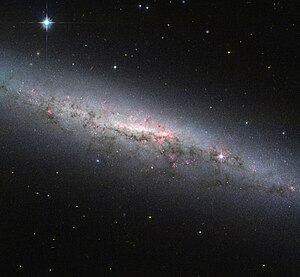NGC 7090
| Galaxy NGC 7090 |
|
|---|---|

|
|
| Photo from the Hubble Space Telescope | |
| AladinLite | |
| Constellation | Indus |
|
Position equinox : J2000.0 , epoch : J2000.0 |
|
| Right ascension | 21 h 36 m 28.8 s |
| declination | -54 ° 33 ′ 26 ″ |
| Appearance | |
| Morphological type | SBc? |
| Brightness (visual) | 10.7 mag |
| Brightness (B-band) | 11.4 mag |
| Angular expansion | 7.3 'x 1.2' |
| Position angle | 127 ° |
| Surface brightness | 12.9 mag / arcmin² |
| Physical data | |
| Affiliation | isolated |
| Redshift | 0.002825 ± 0.000010 |
| Radial velocity | 847 ± 3 km / s |
|
Stroke distance v rad / H 0 |
(36 ± 3) x 10 6 ly (10.9 ± 0.8) Mpc |
| history | |
| discovery | John Herschel |
| Discovery date | October 4, 1834 |
| Catalog names | |
| NGC 7090 • PGC 67045 • ESO 188-12 • IRAS 21329-5446 • 2MASX J21362886-5433263 • SGC 213259-5446.9 • GC 4679 • h 3872 • GALEX MSC J213629.22-543328.8 • HIPASS J2136-54 • 2MIG 2930 | |
NGC 7090 is a barred spiral galaxy of the Hubble type SBc in the constellation Indians in the southern sky . It is estimated to be 36 million light years from the Milky Way and about 85,000 light years in diameter.
The object was discovered on October 4, 1834 by British astronomer John Herschel .
Web links
Commons : NGC 7090 - collection of images, videos, and audio files
